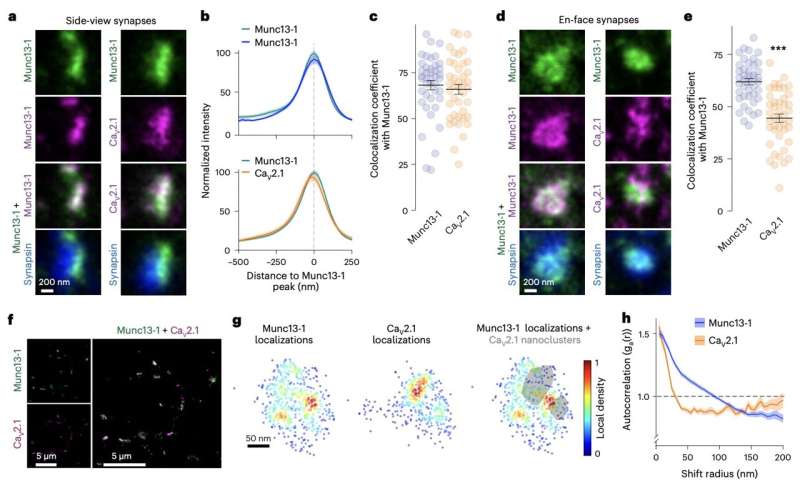September 11, 2024 feature
This article has been reviewed according to Science X's editorial process and policies. Editors have highlighted the following attributes while ensuring the content's credibility:
fact-checked
peer-reviewed publication
trusted source
proofread
Hippocampal study unveils distinct protein machineries for calcium channel clustering and vesicle priming

In neuroscience, the term 'active zone' is used to refer to a specialized area in the presynaptic membrane of synapses (i.e., the connections via which neurons transmit electric nerve signals to each other or to other cells). The active zone is the site where neurotransmitters are released at synapses, thus it plays a central role in neuron-neuron communication.
During an action potential (i.e., an electrical signal that travels within the membrane of neuron to transmit information across the nervous system), synaptic vesicles fuse with the pre-synaptic membrane in response to an influx of Ca2+ ions. This process, which occurs within the active zone, ultimately leads to the release of neurotransmitters into the small gap between the neuron sending an electric signal and the neuron receiving it, known as the synaptic cleft.
Researchers at Harvard Medical School and University of Maryland School of Medicine recently carried out a study investigating protein machinery in the active zone that mediates synaptic vesicle priming and clustering of Ca2+ channels. Their findings, published in Nature Neuroscience, unveil two separate active zone protein machineries at hippocampal synapses that independently execute these functions.
"Action potentials trigger neurotransmitter release at the presynaptic active zone with spatiotemporal precision," Emperador-Melero, Jonathan W. Andersen and their colleagues wrote in their paper.
"This is supported by protein machinery that mediates synaptic vesicle priming and clustering of CaV2 Ca2+ channels nearby. One model posits that scaffolding proteins directly tether vesicles to CaV2s; however, here we find that at mouse hippocampal synapses, CaV2 clustering and vesicle priming are executed by separate machineries."
As part of their studies, the researchers examined floxed mice and previously prepared hippocampal cultures extracted from mice pups using various microscopic, imaging and processing techniques. Their analyses showed that two proteins, namely Cav2 and Munc13, each form nanoclusters positioned at variable distances from each other at hippocampal synapses.
"CaV2 nanoclusters are positioned at variable distances from those of the priming protein Munc13," wrote Emperador-Melero, Andersen and their colleagues.
"The active zone organizer RIM anchors both proteins but distinct interaction motifs independently execute these functions. In transfected cells, Liprin-α and RIM form co-assemblies that are separate from CaV2-organizing complexes. At synapses, Liprin-α1–Liprin-α4 knockout impairs vesicle priming but not CaV2 clustering. The cell adhesion protein PTPσ recruits Liprin-α, RIM and Munc13 into priming complexes without co-clustering CaV2s."
Based on their observations, the researchers conclude that CaV2 clusters and vesicle priming sites are organized independently and are supported by distinct machineries. They also concluded that Liprin-α and PTPσ proteins specifically support priming site assembly.
Overall, these recent findings suggest that there are at least two distinct active zone machineries marked by independent mechanisms that mediate Ca2+ channel clustering and vesicle priming. The researchers hypothesize that the sub-structuring of the active zone they observed contributes to the resilience of synapse and active zone assembly reported in various previous neuroscience studies.
The results gathered as part of this research effort could pave the way for new studies aimed at further investigating the distinct active zone protein machineries identified. This could lead to more interesting observations about the sub-structuring of the active zone, potentially identifying other protein machineries mediating Ca2+ channel clustering and vesicle priming.
More information: Javier Emperador-Melero et al, Distinct active zone protein machineries mediate Ca2+ channel clustering and vesicle priming at hippocampal synapses, Nature Neuroscience (2024). DOI: 10.1038/s41593-024-01720-5
© 2024 Science X Network



















